How not to freeze the water supply in the country
Do-it-yourself winter water supply in the country can be done in two ways:
- bury it so that it does not freeze (below the depth of freezing);
- lay shallow, but with insulation and / or heating.
Thermal insulation of a water supply system is not so much requiring money as labor - digging trenches, laying pipes, wrapping them up, filling and compacting the soil, all this is time and considerable effort. But the result is the availability of water in the house at any time of the year.
The content of the article
Laying pipes below freezing depth
It is advisable to use this method if in winter the soil freezes no deeper than 170 cm. A trench is dug from a well or a well, the bottom of which is 10-20 cm below this value. Sand (10-15 cm) is poured onto the bottom, the pipes are laid in a protective casing (corrugated sleeve), then covered with earth.
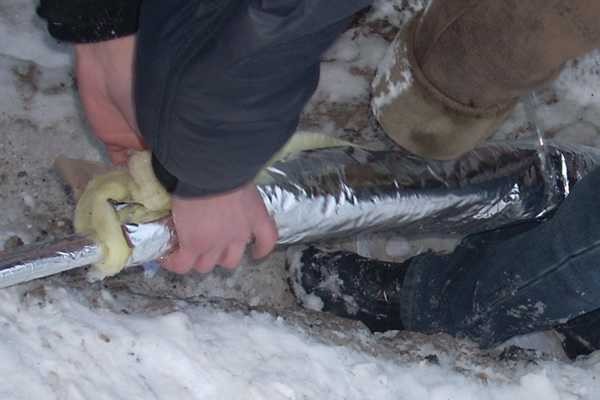
In order not to have to insulate the water supply on the street in frosts, it is better to do this in advance
This is the easiest way to make a winter water supply in the country, but it is not the best, albeit the cheapest. Its main drawback is that if repairs are necessary, you will have to dig again, and to the full depth. And since it is difficult to determine the place of the leak with this method of laying the water supply system, there will be a lot of work.
To make the repairs as few as possible, there should be as few pipe joints as possible. Ideally, they shouldn't be at all. If the distance from the water source to the cottage is greater, make the connections carefully to achieve perfect tightness. It is the joints that flow most often.
The choice of material for pipes in this case is not an easy task. On the one hand, a solid mass presses from above, therefore a strong material is needed, and this is steel. But steel laid in the ground will actively corrode, especially if the groundwater is high. The problem can be solved by priming well and painting over the entire surface of the pipes. Moreover, it is advisable to use thick-walled ones - they will last longer.
The second option is polymer or metal-polymer pipes. They are not susceptible to corrosion, but they must be protected from pressure - placed in a protective corrugated sleeve.
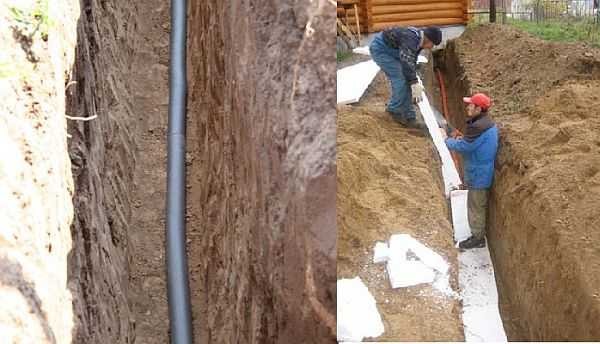
Even if the ditch was dug below the freezing level, it is better to insulate the pipes.
One more point. The depth of soil freezing in the region is determined over the past 10 years - its average indicators are calculated. But first of all, very cold and little snowy winters periodically occur, and the ground freezes deeper. Secondly, this value is the average for the region and does not take into account the conditions of the site. Perhaps it is on your piece that there may be more freezing. All this means that when laying pipes, it is still better to insulate them, lay sheets of polystyrene or expanded polystyrene on top, as in the photo on the right, or lay them in thermal insulation, as on the left.
You may be interested in reading "How to make automatic watering«.
Insulation of the pipeline
Making water supply to a private house from a well and a well, the pipeline can be laid at a very shallow depth - 40-50 cm - this is quite enough. It is only necessary to lay pipes in such a shallow trench insulated. If you want to do everything thoroughly, then lay out the bottom and sides of the trench with some kind of building material - brick or building blocks. From above, everything is covered with plates.
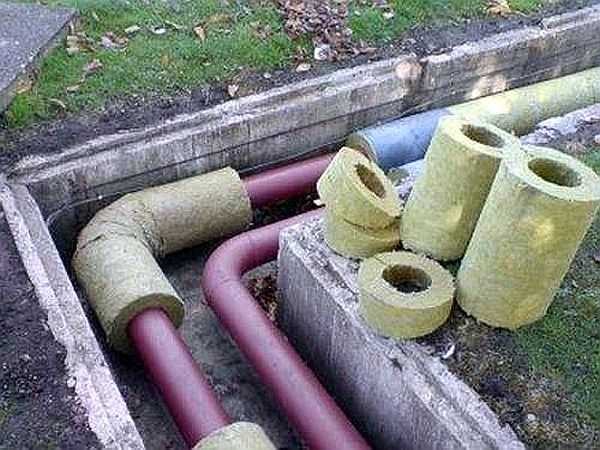
An example of laying pipes above the freezing depth in a prepared ditch. Insulation of the water supply system is carried out with a special insulation, with a suitable inner diameter
If desired, you can fill up the soil and plant annuals - if necessary, the soil can be easily removed and free access to the pipeline is provided.
Insulation for water pipes
You can use two types of insulation:
- special energy-saving casings molded in the form of pipes, they are also called "shells for pipes";
- roll material - ordinary insulation in the form of rolls, which is used for walls, roofs, etc.
Insulation for pipes in the form of a shell is made from the following materials:
- Expanded polystyrene - multiple granules are fused together. The result is a fairly tough and durable material with good thermal insulation characteristics.
- Extruded polystyrene foam - the cells of the material have a closed structure (small balls). This also gives the material water-repellent properties, as well as higher thermal insulation properties. It is one of the best materials with a high degree of insulation, but its disadvantage is its high price.
- Polyfoam - one of the options for expanded polystyrene - has good thermal insulation characteristics, but it is not very durable. Therefore, it needs protection - it cannot stand pressure. But it costs a little. If you will lay pipes in a trench with walls made of brick or concrete, it can be used.
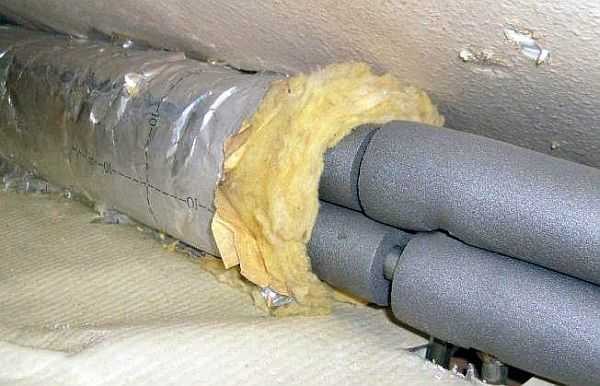
Nobody bothers to play it safe and use two layers of insulation
- Polyurethane foam - in terms of characteristics and price, it is between polystyrene foam and foam. It is it that is most often used for pipe insulation.
- Foamed polyethylene ("Energoflex" type) has good characteristics due to the high content of air in the bubbles.
- Glass wool is a roll material with good thermal insulation characteristics and a relatively low price. Its disadvantage is that special measures are needed when laying: fiberglass is very prickly, and it is unrealistic to remove microscopic particles from the skin. You also need a respirator and goggles - small particles are volatile and harmful to health.
- Stone wool. It is made from basalt or slag. Basalt wool has the best characteristics, but is expensive. Slag is a cheaper material, but its characteristics are worse - you need to take a larger thickness, which often reduces material benefits to a minimum.
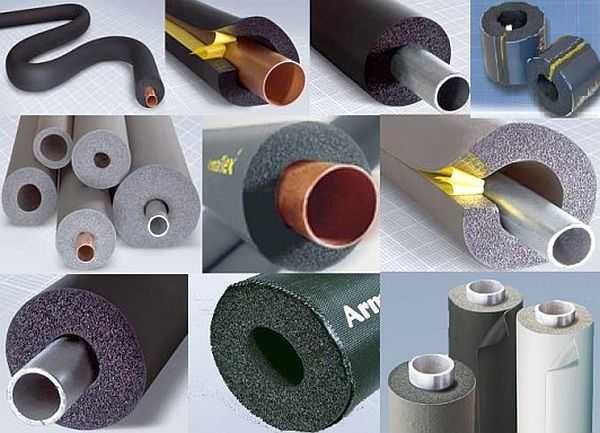
Insulation of water supply pipes in a private house is done using thermal insulation
Mineral wool - glass wool and stone wool - has one significant drawback: they are hygroscopic. By absorbing water, they lose most of their thermal insulation properties. After drying, they are only partially restored. And another very unpleasant moment, if wet mineral wool freezes, it turns into dust after freezing. To prevent this from happening, these materials require careful waterproofing. If you cannot guarantee moisture will be free, use a different material.
How to make do-it-yourself drip irrigation systems for greenhouses and vegetable gardens is written here. About manufacturers of ready-made kits for drip irrigation articlehere.
Heating
When planning a winter water supply system, you need to keep in mind that insulation only helps to reduce heat loss, but it cannot heat. And if at some point the frosts turn out to be stronger, the pipe will freeze. Particularly problematic in this sense is the section of the pipe output from the underground sewage system to the house, even if it is heated. All the same, the soil near the foundation is often cold, and it is in this area that problems most often arise.
If you do not want to freeze your water supply, do pipe heating. For this use heating cable or heating plates - depending on the diameter of the pipes and the required heating power. Cables can be laid lengthwise or wound in a spiral.
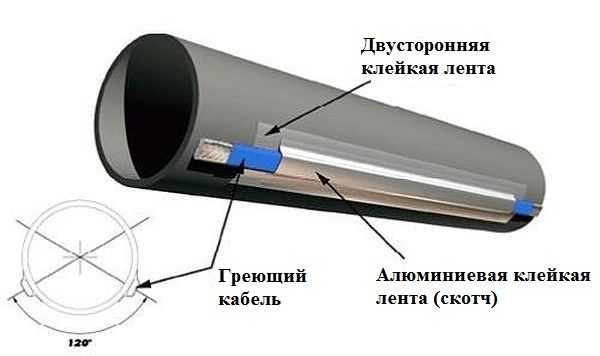
Method of fixing the heating cable to the water pipe (the cable must not lie on the ground)
The heating cable is good for everyone, but it's not uncommon for us to have power outages for several days. What will happen to the pipeline then? The water will freeze and can burst pipes. And repair work in the middle of winter is not the most pleasant experience.Therefore, several methods are combined - and the heating cable is laid, and insulation is on it. This method is also optimal from the point of view of minimizing costs: under thermal insulation, the heating cable will consume a minimum of electricity.
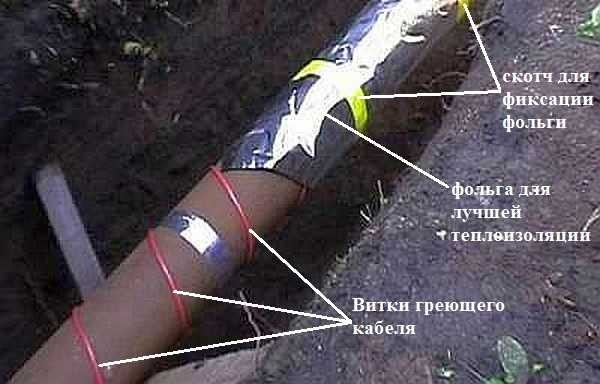
Another way to fix the heating cable. To make electricity bills less, you also need to install an insulating shell on top or fix roll insulation
Laying a winter water supply system in the country can be done using this type of thermal insulation, as in the video (or you can take an idea into service and do something similar with your own hands).
The development of a scheme for laying a water supply system in the country is described here.
Winter water supply in the country: new technologies in insulation
There is an interesting option, a polymer flexible pipe, insulated at the factory. On top of the insulation there is a layer of waterproofing, and along the pipe there is a channel for laying the heating cable. Such pipes are called non-freezing pipes or insulated pipes. For example, even in the northern regions, it is possible to make a winter water supply at the dacha on the surface using the IZOPROFLEX-ARKTIK pipes.
Working temperature - up to -40 ° C, working pressure - from 1.0 to 1.6 MPa, pressure pipe diameter - from 25 mm to 110 mm. It can be laid in a channel or on a surface. They are flexible, delivered in coils of the required length, which allows us to minimize the number of joints.
There is also a new way to insulate a winter water supply system in the country - liquid thermal insulation or thermal insulation paint. It can be applied to an already installed plumbing, which can be a good solution.











